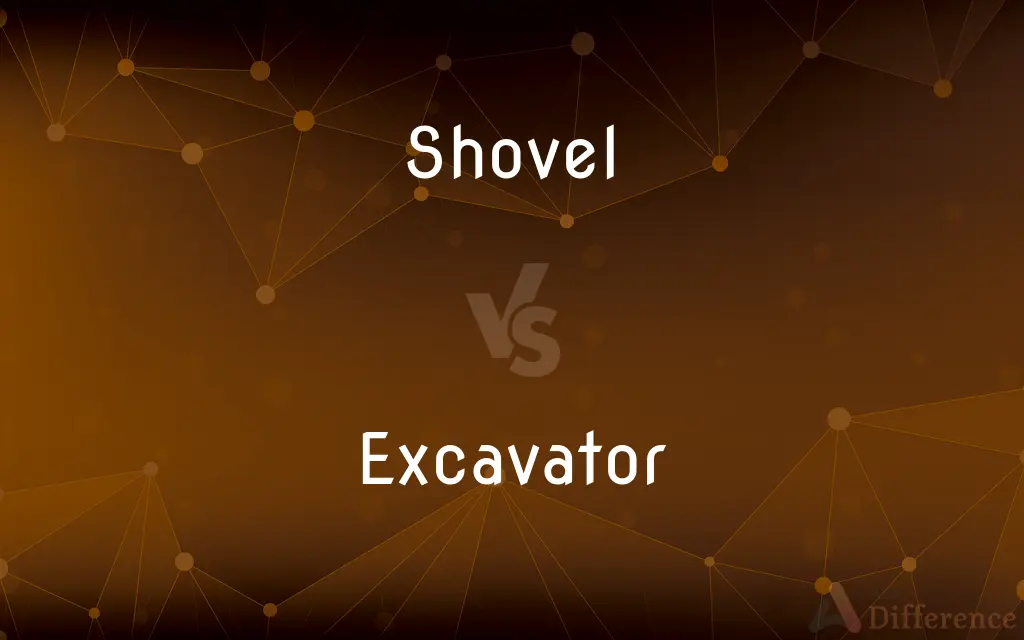Shovel vs. Excavator — What's the Difference?
Edited by Tayyaba Rehman — By Urooj Arif — Updated on March 11, 2024
A shovel is a hand tool for digging, lifting, and moving material, while an excavator is a heavy equipment machine for large-scale digging and demolition tasks.

Difference Between Shovel and Excavator
Table of Contents
ADVERTISEMENT
Key Differences
A shovel is a manual tool that consists of a broad blade fixed to a medium-length handle, used for digging, lifting, and moving loose material like soil, coal, gravel, or snow. It requires physical labor and is most effective for small-scale tasks, such as gardening, minor excavation, or snow removal. On the other hand, an excavator is a large construction machine that includes a boom, dipper (or stick), bucket, and cab on a rotating platform known as the "house." The house sits atop an undercarriage with tracks or wheels. Excavators are designed for much larger tasks, including heavy construction work, mining, demolition, and large-scale excavation.
Shovels are versatile tools that can be used in various environments and applications, from residential gardening to small construction projects. They are portable, require no fuel or electricity to operate, and are available in different shapes and sizes to suit specific tasks, such as spades for digging, flat shovels for scooping, and trench shovels for creating narrow trenches. Conversely, excavators are used in professional settings like construction sites, mining operations, and large landscaping projects. They are equipped with hydraulic systems that provide significant power for digging, lifting heavy loads, and demolition work. Due to their size and complexity, excavators require trained operators to control them.
The operational scope of shovels is limited by human strength and endurance, making them suitable for tasks that can be completed by one or two people. They are cost-effective for small jobs and require minimal maintenance. Excavators, however, can complete extensive and labor-intensive tasks more quickly and efficiently than manual labor alone could achieve. The cost of purchasing or renting an excavator is substantially higher than that of a shovel, and it also incurs operating and maintenance costs.
Safety considerations for using a shovel include the risk of back injuries from improper lifting techniques and potential strain from repetitive motions. Proper use and personal protective equipment can mitigate these risks. For excavators, safety concerns are more complex and include the risk of tipping, collision, or accidental damage to underground utilities. Operators must undergo specialized training and adhere to strict safety standards to prevent accidents.
While a shovel represents a basic, indispensable tool for personal and small-scale commercial use, an excavator embodies the technological advancement in construction and excavation, enabling the execution of large-scale projects with efficiency and precision. The choice between a shovel and an excavator depends on the scale of the task, the available budget, and the desired speed of completion.
ADVERTISEMENT
Comparison Chart
Primary Use
Digging, lifting, moving material
Large-scale digging, demolition
Operation
Manual labor
Hydraulic power
Scale of Tasks
Small-scale tasks
Large-scale construction and demolition
Cost
Low purchase cost, minimal maintenance
High purchase/rental cost, operational and maintenance expenses
Safety
Risk of back injuries, strain
Risks of tipping, collision, underground utility damage
Compare with Definitions
Shovel
A hand tool with a broad blade and handle used for digging and moving materials.
He grabbed a shovel to start planting the new flowers in the garden.
Excavator
Operators need specialized training.
Before operating the excavator, he completed a certified training course.
Shovel
Suitable for gardening, minor excavations, and snow removal.
She used a flat shovel to clear the driveway after the snowstorm.
Excavator
Essential in construction, mining, and large landscaping projects.
Excavators are a common sight in large-scale construction sites.
Shovel
Requires manual labor and physical strength.
Digging the post holes with a shovel was physically demanding work.
Excavator
A heavy construction machine for digging, demolition, and heavy lifting.
The construction crew used an excavator to dig the foundation for the new building.
Shovel
Low initial cost and no operational expenses.
Buying a shovel for the small garden was a cost-effective decision.
Excavator
Involves significant investment and operating expenses.
Renting an excavator for the project was a major part of the budget.
Shovel
Proper lifting techniques are necessary to avoid injury.
He made sure to bend his knees while shoveling to prevent back strain.
Excavator
Can complete labor-intensive tasks quickly.
The excavator completed in hours what would have taken days manually.
Shovel
A shovel is a tool for digging, lifting, and moving bulk materials, such as soil, coal, gravel, snow, sand, or ore. Most shovels are hand tools consisting of a broad blade fixed to a medium-length handle.
Excavator
Excavators are heavy construction equipment consisting of a boom, dipper (or stick), bucket and cab on a rotating platform known as the "house". The house sits atop an undercarriage with tracks or wheels.
Shovel
A tool with a handle and a broad scoop or blade for digging and moving material, such as dirt or snow.
Excavator
A person who excavates an archaeological site.
Shovel
A large mechanical device or vehicle for heavy digging or excavation.
Excavator
A large machine for digging and moving earth.
Shovel
The amount that a shovel can hold; a shovelful
One shovel of dirt.
Excavator
One that excavates, especially a machine used for digging having a bucket attached to a two-part boom and a rotating cab for the operator.
Shovel
To move or remove with a shovel.
Excavator
A person who excavates.
Shovel
To make with a shovel
Shoveled a path through the snow.
Excavator
A vehicle, often on tracks, used to dig ditches etc.Excavator
Shovel
To convey or throw in a rough or hasty way, as if with a shovel
He shoveled the food into his mouth.
Excavator
A curette used to scrape out pathological material.
Shovel
To clear or excavate with or as if with a shovel
Shoveling off the driveway after the snowstorm.
Shovels out the hall closet once a year.
Excavator
One who, or that which, excavates or hollows out; a machine, as a dredging machine, or a tool, for excavating.
Shovel
To dig or work with a shovel.
Excavator
A workman who excavates for foundations of buildings or for quarrying
Shovel
A hand tool with a handle, used for moving portions of material such as earth, snow, and grain from one place to another, with some forms also used for digging. Not to be confused with a spade, which is designed solely for small-scale digging and incidental tasks such as chopping of small roots.
Excavator
A machine for excavating
Shovel
A mechanical part of an excavator with a similar function.
Shovel
(US) A spade.
Shovel
To move materials with a shovel.
The workers were shovelling gravel and tarmac into the pothole in the road.
After the blizzard, we shoveled the driveway for the next two days.
I don't mind shoveling, but using a pickaxe hurts my back terribly.
Shovel
To move with a shoveling motion.
Already late for work, I shovelled breakfast into my mouth as fast as possible.
Shovel
An implement consisting of a broad scoop, or more or less hollow blade, with a handle, used for lifting and throwing earth, coal, grain, or other loose substances.
Shovel
To take up and throw with a shovel; as, to shovel earth into a heap, or into a cart, or out of a pit.
Shovel
To gather up as with a shovel.
Shovel
A hand tool for lifting loose material; consists of a curved container or scoop and a handle
Shovel
The quantity a shovel can hold
Shovel
A fire iron consisting of a small shovel used to scoop coals or ashes in a fireplace
Shovel
A machine for excavating
Shovel
Dig with or as if with a shovel;
Shovel sand
He shovelled in the backyard all afternoon long
Common Curiosities
What is the environmental impact of using an excavator?
Excavators produce emissions and can disturb large areas of land quickly, impacting the environment more significantly than manual tools like shovels.
How does the efficiency of an excavator compare to manual digging?
An excavator can perform digging tasks significantly faster and with less human effort than manual digging with shovels.
How do you choose between using a shovel or an excavator for a project?
The choice depends on the project scale, budget, and time constraints. For small, budget-sensitive tasks, a shovel is adequate. For large, time-sensitive projects, an excavator is more efficient.
What can a shovel do that an excavator cannot?
A shovel is more suitable for precision tasks in tight or delicate areas where a large machine cannot fit or would cause too much disruption.
Can a shovel and an excavator be used together on a project?
Yes, on many construction or landscaping projects, both tools are used in tandem. Shovels can handle precise, small-scale tasks or finishing work, while excavators are used for the bulk of the excavation, demolition, or heavy lifting.
How do maintenance requirements compare between a shovel and an excavator?
A shovel has minimal maintenance requirements, mainly cleaning and perhaps sharpening if it has a cutting edge. An excavator requires regular maintenance, including engine checks, hydraulic system inspections, and track or wheel maintenance, to ensure it operates safely and efficiently.
Can excavators be used for tasks other than digging?
Yes, with different attachments, excavators can perform a variety of tasks including demolition, heavy lifting, grading, and even drilling.
What are the training and skill requirements for operating a shovel versus an excavator?
Operating a shovel requires basic physical ability and knowledge of proper lifting techniques to avoid injury. Operating an excavator requires specialized training, often including certification, to safely and effectively use the machinery.
What types of materials can be moved with a shovel versus an excavator?
A shovel is best for moving smaller amounts of loose materials like soil, gravel, or snow. An excavator can move large volumes of a wide range of materials, including heavy rocks, large amounts of earth, and debris from demolition.
How does the cost of operation affect the choice between a shovel and an excavator?
For small projects or occasional use, a shovel is more cost-effective due to its low purchase price and lack of operational costs. For larger projects, the efficiency and versatility of an excavator can justify its higher rental, purchase, and operational costs.
Share Your Discovery

Previous Comparison
Refundee vs. Refunder
Next Comparison
Brink vs. EdgeAuthor Spotlight
Written by
Urooj ArifUrooj is a skilled content writer at Ask Difference, known for her exceptional ability to simplify complex topics into engaging and informative content. With a passion for research and a flair for clear, concise writing, she consistently delivers articles that resonate with our diverse audience.
Edited by
Tayyaba RehmanTayyaba Rehman is a distinguished writer, currently serving as a primary contributor to askdifference.com. As a researcher in semantics and etymology, Tayyaba's passion for the complexity of languages and their distinctions has found a perfect home on the platform. Tayyaba delves into the intricacies of language, distinguishing between commonly confused words and phrases, thereby providing clarity for readers worldwide.














































